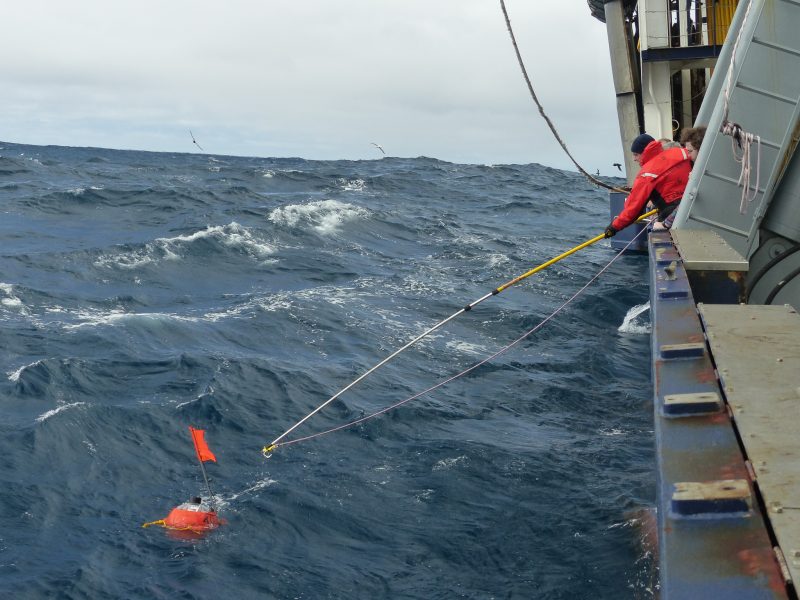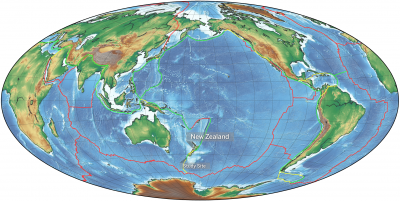UT Graduate Student Research Solves Plate Tectonics Mystery
February 14, 2022

The longstanding enigma of how tectonic plates can break Earth’s rock-hard shell may have been solved by a recent graduate student at The University of Texas at Austin who caught the Earth in the act of starting a new tectonic conveyor belt off the coast of New Zealand. The world’s tectonic conveyor belts – called subduction zones – are the engines moving the continents and oceans that sit atop tectonic plates.

The study of the emerging subduction zone was published Feb. 10, 2022, in the journal Nature Geoscience. It describes how a small break in the tectonic plate was squeezed and pulled over millions of years until it unzipped and set in motion a runaway geologic process, said Brandon Shuck, who did the work for his doctoral thesis at the UT Jackson School of Geosciences and is now a postdoctoral research scientist at Columbia University’s Lamont-Doherty Earth Observatory.
“We now know how subduction nucleated and how fast it’s growing,” he said. “That’s important to know because subduction is the main driver of plate tectonics. It builds mountains, forms new oceans and drives chemical cycling from the deep earth all the way to the atmosphere.”
Today, Earth is unique among its rocky planetary neighbors in having plate tectonics. Information from Shuck’s findings will help scientists understand how the process started on Earth and how it could work on other worlds, said the study’s co-author Harm Van Avendonk, a senior research scientist at the University of Texas Institute for Geophysics (UTIG), where he supervised Shuck’s research.
“We do believe that subduction didn’t always happen on Earth, so understanding how subduction initiates today is a critical step to understanding how our world eventually became a habitable planet,” Van Avendonk said.

The research began in 2018 aboard a UT-led scientific research cruise off the coast of New Zealand, where Shuck and his crewmates endured weeks of bad weather to gather detailed seismic images of the fault.
Onshore, Shuck matched the images with rock samples from other ocean drilling expeditions, providing a geologic timeline to reconstruct the unzipping plate. According to his reconstruction, a small break appeared in the Australian plate around 16 million years ago that slowly grew as it collided with other tectonic plates. When the break had unzipped far enough, the heavier portion of the plate broke through the Earth’s rocky shell (known as the lithosphere), setting it on an unstoppable downward conveyor into the Earth that has continued for the last 8 million years.
Today, the new subducting margin is about 300 miles long.
“That’s pretty small at the scale of global tectonics,” Shuck said. “But it’s going to keep growing all the way down to Antarctica. Once it gets that big (more than 1,000 miles long) it could change the motion of neighboring tectonic plates.”
For now, the only sign on the surface is a handful of volcanoes near New Zealand’s South Island. Most emerged in the last hundred thousand years, but they are likely to grow into a volcanic chain as the split spreads south over the coming millennia, he added.
Shuck’s study reconciles two opposing ideas about how subduction starts: With the gradual back and forth of plates bumping against one another, or by plates spontaneously and rapidly collapsing under their own weight. The new research suggests that sometimes the two ideas might both be part of the equation.
“The work shows that there may, instead, be multiple scenarios driving subduction initiation,” said Fabio Crameri, a Swiss geophysicist who maintains a database of the world’s past and present subduction zones and who was not involved in the study. “Even if the same scenario isn’t true for every subduction zone, their model challenges our current systems for classifying subduction zone initiation and highlights the need for 4D modelling of them.”
The research was supported by the National Science Foundation, which also funded the 2018 cruise, South Island Subduction Initiation Experiment, aboard the RV Marcus Langseth. Shuck’s doctoral degree was supported by the UTIG Ewing and Worzel Graduate Fellowship. UTIG is a research unit of the Jackson School.
Constantino Panagopulos, University of Texas Institute for Geophysics, 512-574-7376; Monica Kortsha, Jackson School of Geosciences, 512-471-2241; Anton Caputo, Jackson School of Geosciences, 512-232-9623.
